Hambledon, Surrey
Up to 1834
A parliamentary report in 1777 recorded parish workhouses in operation at Chiddingfold (for up to 12 inmates), Hambledon (8), Haslemere (30), and Witley (30).
In around 1785, Hambledon and the nearby parishes of Bramley, Chiddingfold and Dunsfold formed a union under Gilbert's Act of 1782, which allowed adjacent parishes to set up workhouses for the elderly and infirm and children. The union erected a workhouse on Wormley Lane, Hambledon, in 1786. Elstead, Hascombe, Haslemere and St-Martha-on-the-Hill (Chilworth) subsequently joined the union.
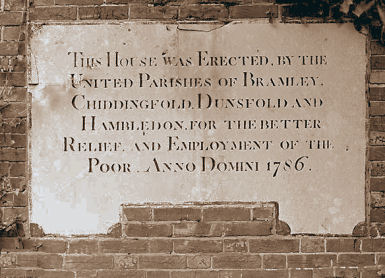
Hambledon workhouse foundation plaque.
Another pre-1834 workhouse existed at Cranley (renamed Cranleigh in around 1869 to avoid hand-written confusion with Crawley). It was located to the west of the village at the south of Cranley Common as shown on the 1872 map below.
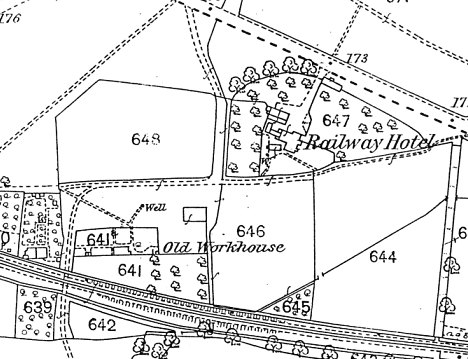
Cranleigh site, 1872.
Cranley workhouse was researched in parish records by now-deceased local historians Messrs Seymour and Warrington, whose findings (based on their rough notes) are included below courtesy of the Cranleigh Local History Group.
All able-bodied workhouse inmates were expected to work, the men at grave digging or stone breaking, and cracking flints to mend roads. Women at various forms of housework, sewing and laundry. Both sexes made and sold shoes and sorted and sold bones. Married men were paid 1/- a week with one penny extra for each child. Workhouse wages rose considerably after 1823.
If under age of 60 wives and husbands were parted and obliged to live in opposite wings of the house. Outings were limited to 2 per week, i.e. 2 church services, unless special permission was given. The workhouse inmates were segregated from the rest of the congregation.
1821
The paupers of Cranley took their parochial relief at the shops in the parish which was thought 'highly improper' by the meeting held in the workhouse on Tuesday 3rd July. and it was to be discontinued. The chairman was J N Smallpiece. Also parochial allowances for children from that day were to be reduced.
August meeting. It was decided to move the almshouses to a more proper place and the workhouse heating was to be immediately repaired.
At a meeting held in the Onslow Arms in October 1821 it was decided that Charles Potterton and his wife should be removed from their cottage and taken to the workhouse. Henry Jarrett and his wife were also ordered to the workhouse where they were to arrive at 8.30 a.m. If late a fine of 5/- was levied on each man and woman. The parish constable was present to see that the orders were carried out
On 12 December, a meeting at the workhouse discussed that the parish of Wonersh should be required to take their paupers from Cranley on or before January 1822 and be required to pay all interest and rent arrears and unless said arrears were paid by 1 January 1822 all paupers would be turned out of Cranley workhouse.
Average number of inhabitants of workhouse was 21.
1822
July Meeting. It was resolved that the west wing of the poor house be pulled down and sold, the remainder of the house being sufficient for parish poor. The dying room and hospital to be converted into tenements for the poor.
4th November. (No name) fined by the Guildford Bench for stealing faggots and the money was distributed to paupers Budgen, Bignal, Stedman, Luff and Sparks, old men in the house (1/- each).
1823
April Edward Mercer. wife and children should be removed from the workhouse to a cottage in Cranley parish lately occupied by 'old' Thomas Wood
The west wing of the workhouse - agreed to be taken down and materials sold. Money to be given to pay for repairs to the rest of it. (A school room Las to have been built). Also 2 rooms for use of the Master.
1823 Men employed by the workhouse to be paid:-
Man's wife 1/-
Man's wife end 1 child 1/2d
Mans wife and 2 child 1/3d
Man's wife and 3 child and upwards 1/3d.
1824
Feb (?) Elizabeth Butcher and Mary Channel given notice to quit workhouse in a fortnight and provide for themselves.
Arthur Hasty, widower with 2 small boys and one girl, was permitted to leave his sons in the workhouse for a short period.
A young girl, Leah Edwards, was sent to be a housemaid to a G Saddler She was paid 1/- a week with all cloths provided apart from shoes and bonnets.
Thomas Potter. vestry clerk, to attend workhouse with Henry Hedger for the purpose of valuing clothes and furniture of paupers admitted to the house and leaving.
1826
George Chitty, a Cranley blacksmith, was left a widower with 2 small sons. He was unable to find work locality but found a job in Leatherhead which was too far for his two sons to travel. The workhouse authorities reluctantly agreed to take the boys in providing their father handed over two thirds of his 6/- wage each week.
Later Events
In 1836 Thomas Walker and his wife Harriet were engaged as Master and Mistress of the workhouse. George Fielder and his wife Eleanor were Master and Mistress in 1837 when an epidemic swept through the workhouse. Frederick Yates, the surgeon. tended the patients and was awarded £30 for overtime during this epidemic and out of this sum he was expected to pay for medicines, instruments, leeches, and cupping etc.
A fund of £75 was set up in order that the churchwardens and overseas of the poor could assist any persons who wished to emigrate. Leslie Elliot, with his wife and 7 children. and another man with six children agreed to try their luck in America. They were assisted with money for their passage and given 2 sovereigns each. After landing in America expenses to their final destinations were paid and each family received another sovereign In 1843 four young men were given £11.16.0 to emigrate to New Zealand
The workhouse proved too expensive to run for a small village and it was sold in 1842 for £415 to Lord Grantley who was very slow to pay. Lord Grantley used the building as a corn store. In 1842, it caught fire and the larger part was destroyed. The remains were renovated and lived in by Cooper (?) Sutherland, a farmer, until the end of World War One. The building no longer exists.
After 1834
Hambledon Poor Law Union was formed on 25th March 1836. Its operation was overseen by an elected Board of Guardians, 18 in number, representing its 16 constituent parishes as listed below (figures in brackets indicate numbers of Guardians if more than one):
County of Surrey: Alfold, Bramley, Chiddingfold, Chilworth—St Martha, Cranley [Cranleigh] (2), Dunsfold, Elstead, Ewhurst, Hambledon, Hascomb, Haslemere, Pepper Harrow, Shalford, Thursley, Witley (2), Wonersh.
The population falling within the Union at the 1831 census had been 11,882 with parishes ranging in size from Pepper Harrow (population 144) to Whitley (1,376). The average annual poor-rate expenditure for the period 1833-35 had been £12,546 or £1.1s.1d. per head of the population.
The new Hambledon Poor Law Union took over the existing Hambledon Gilbert Union workhouse site.
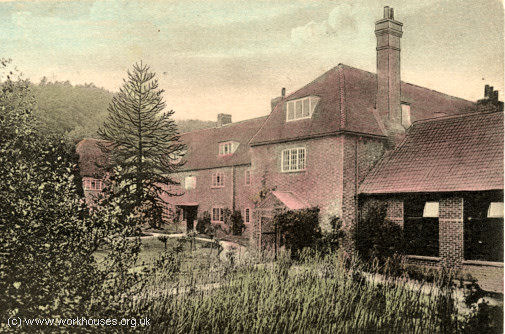
Hambledon main block from the south, c.1918.
© Peter Higginbotham.
The main workhouse building was based on a square plan with a central block dividing the inner area into two. A plan of the building from 1875 gives its layout as shown below:
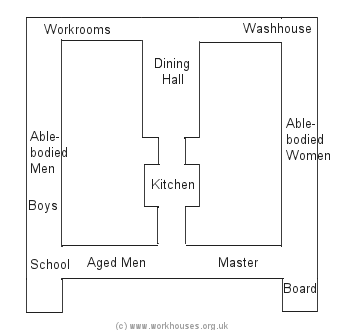
Hambledon workhouse, 1875.
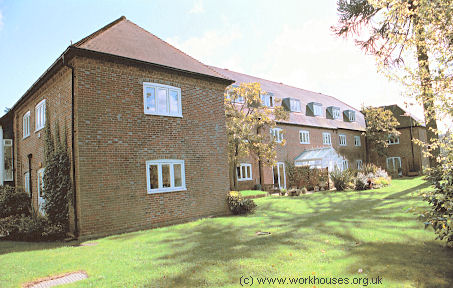
Hambledon main block from the west, 2001.
© Peter Higginbotham.
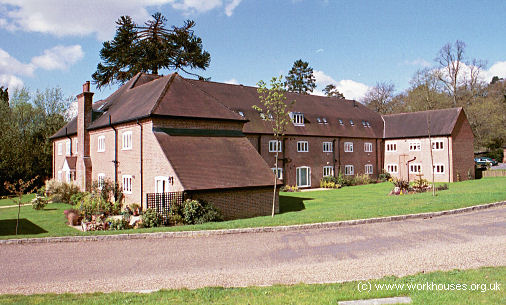
Hambledon main block from the north-east, 2001.
© Peter Higginbotham.
A separate infirmary block was erected to the north of the site, and a new mortuary added to it in 1875. A new Board-room was erected in 1882. The workhouse location and layout are shown on the 1895 map below.
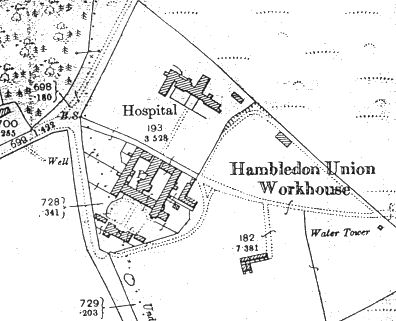
Hambledon site, 1895.
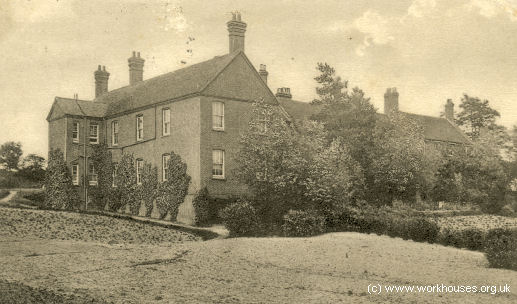
Hambledon infirmary from the south-west, c.1907.
© Peter Higginbotham.
After 1930, Surrey County Council took over the site which became a Public Assistance Institution, with the infirmary known as Hambledon Hospital. In 1940, the children's accommodation was converted for use as a nursery for twenty young children and six nursing mothers. In 1942, the premises became home to King Edward's School, Witley, whose own building had been requisitioned by the Admiralty. After the School departed in 1949, the site housed an old people's residence, Hambledon Homes, until the 1970s. In the 1980s, the site was occupied by the Institute of Oceanographic Sciences. The surviving buildings have now been converted for residential use.
Peter Collier, whose parents were Superintendent and Matron at Hambledon from 1950 until 1958, recalls:
Although Hambledon may have closed as a hospital, during my parents' period there it was in use by residents of the old peoples' home which it had become under the aegis of Surrey County Council.
A new accommodation block had been built in the grounds for resident staff and the Superintendent and Matron. The former gatehouse was in use as the Superintendent`s office. A detached house in the grounds (shown below the number 182 on your map) was also part of the female residents` accommodation known at the time as 'the lower home'.
The original workhouse buildings were not used for residential purposes initially as I recall (they were partly empty, partly storage and contained the seamstress's room) but were later occupied by the mothers and children of homeless/evicted families (though not including male members) from 1953 or thereabouts.
Staff
Inmates
Records
Note: many repositories impose a closure period of up to 100 years for records identifying individuals. Before travelling a long distance, always check that the records you want to consult will be available.
- Surrey History Centre, 130 Goldsworth Road, Woking, Surrey GU21 6ND. Very few records survive — holdings include Guardians' minutes (1836-1929); etc.
- FindMyPast has searchable versions of the Guardians' minute books (1872-1910).
Bibliography
- Higginbotham, Peter Workhouses of London and the South East (2019)
Links
- None.
Acknowledgments
- Thanks to Michael Allbrook for information on Cranley workhouse.
Unless otherwise indicated, this page () is copyright Peter Higginbotham. Contents may not be reproduced without permission.


